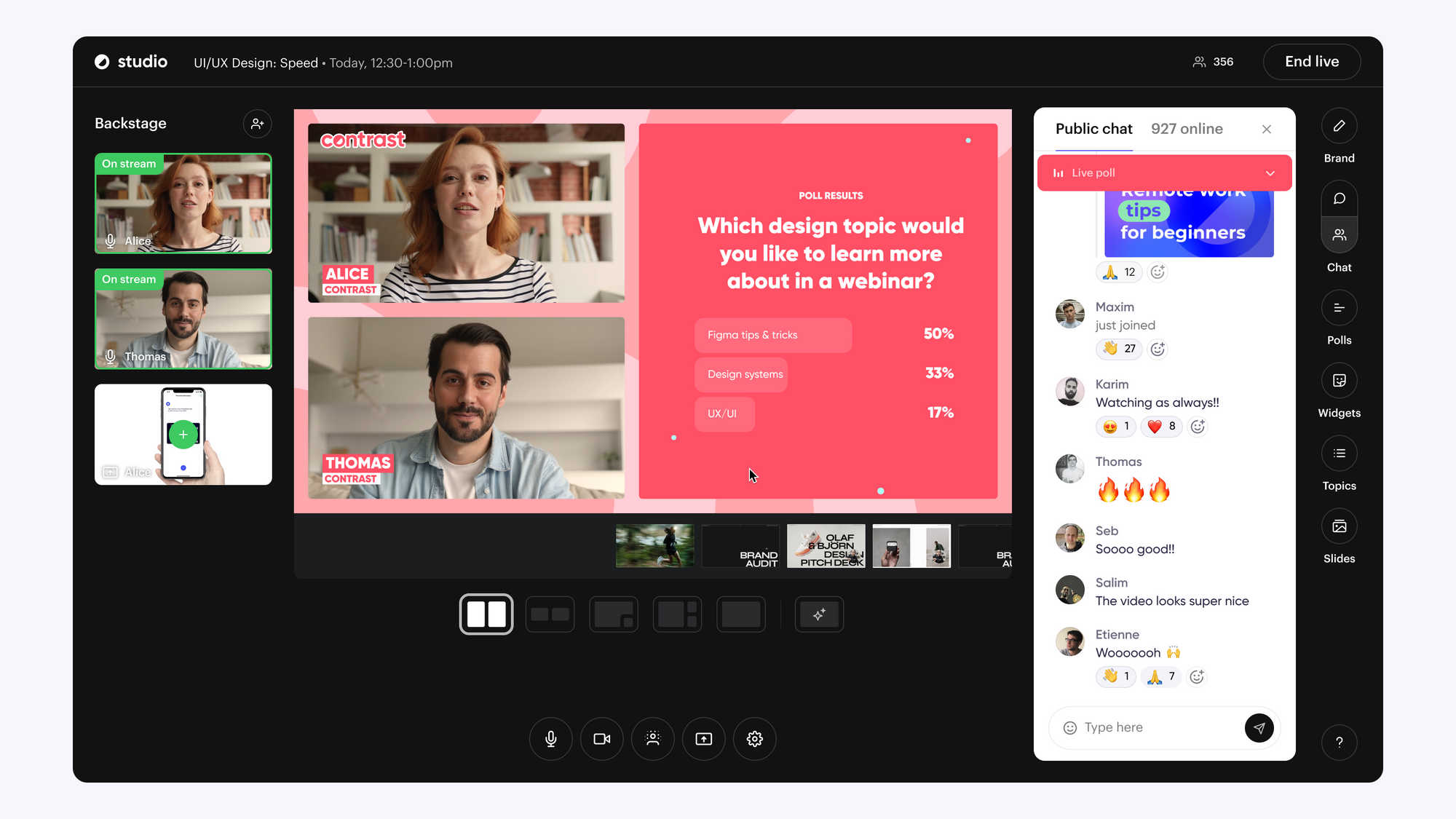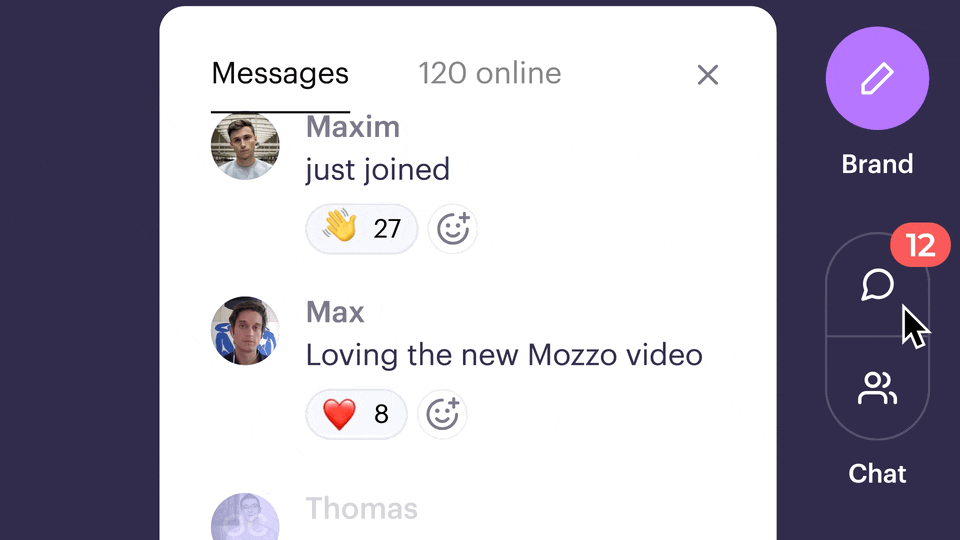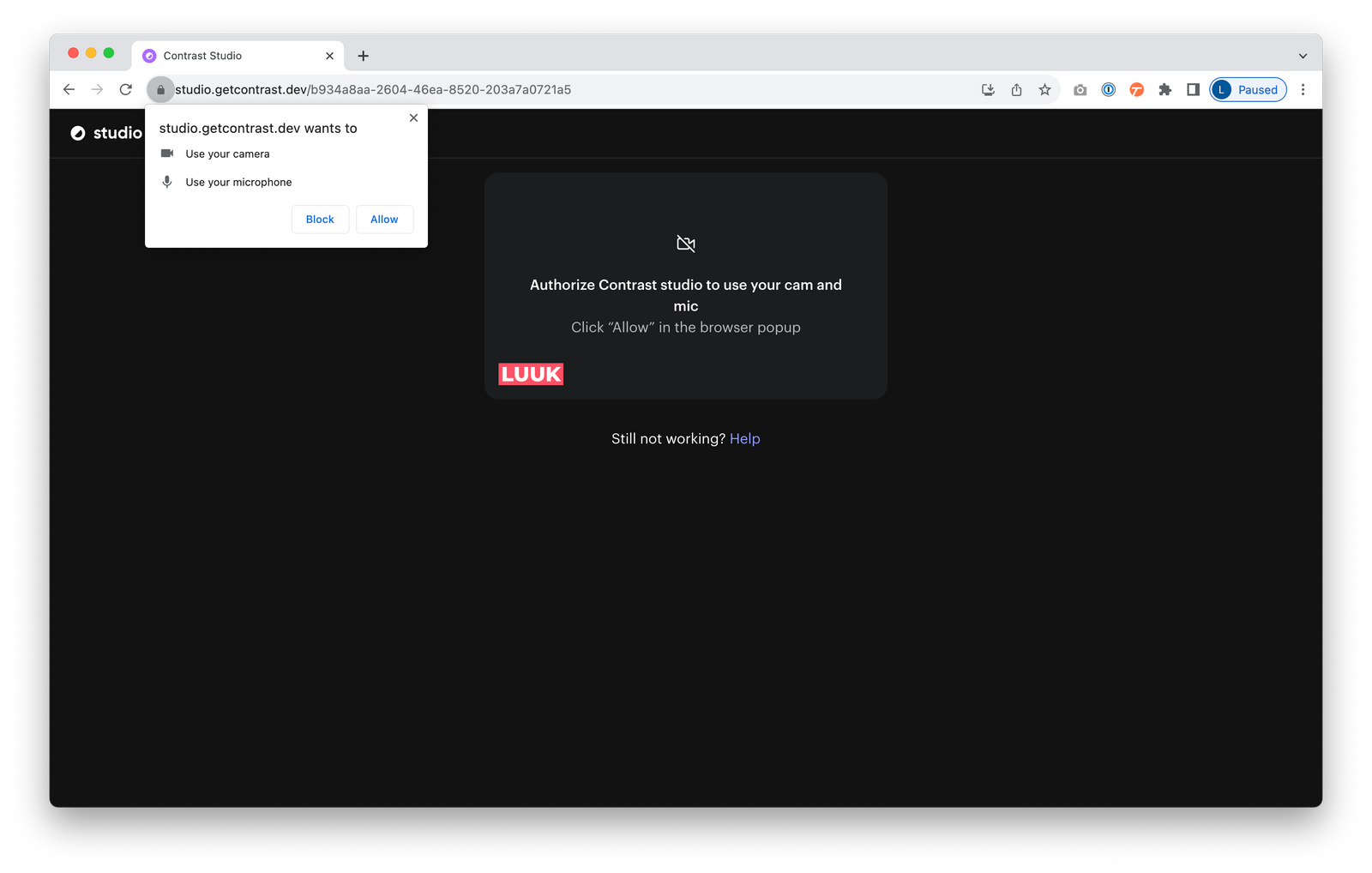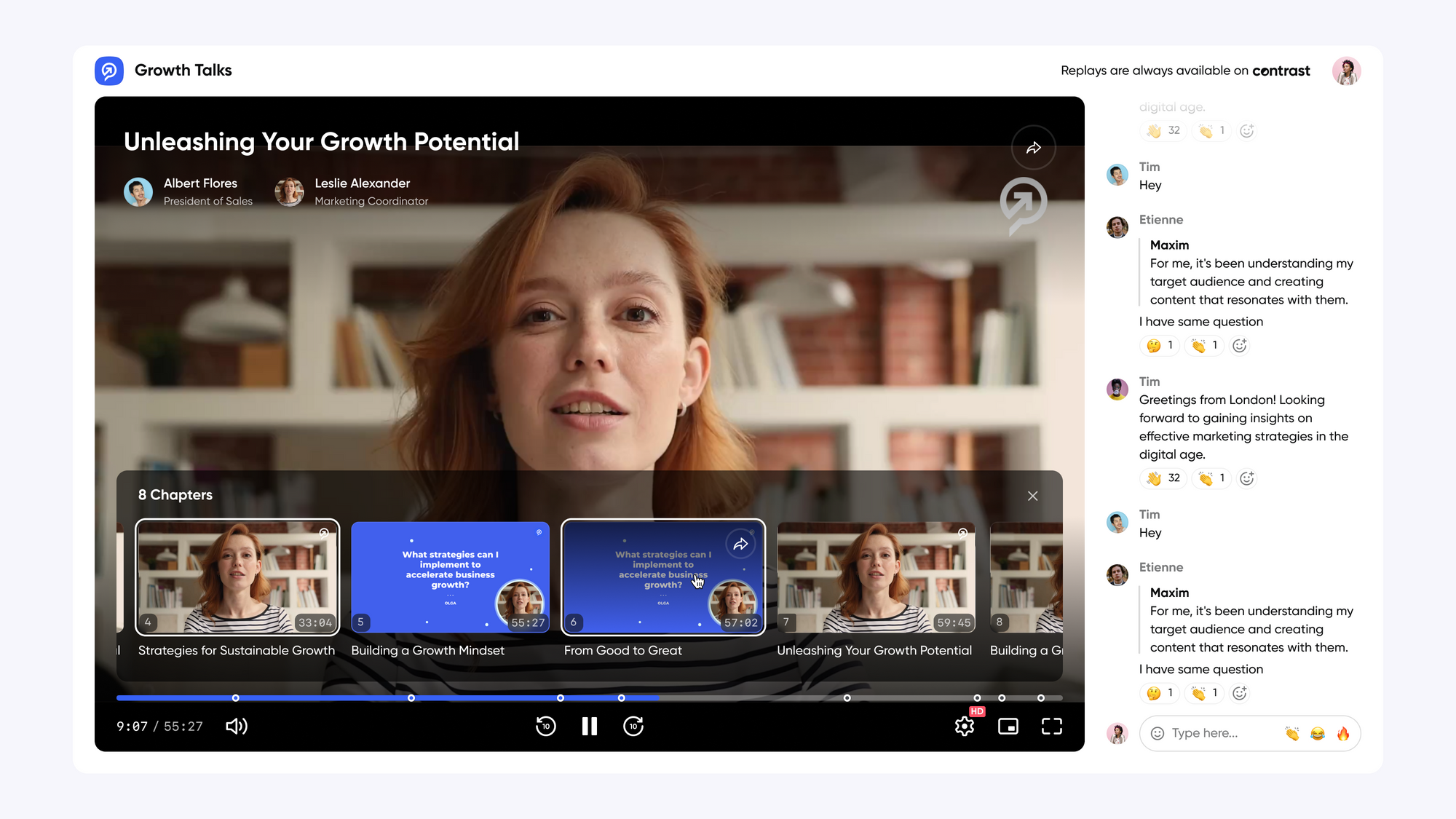Webinar Best Practices: Everything you Need to Know (2025)

Introduction
Imagine a gripping blockbuster movie trailer, filled with anticipation and intrigue. That's this post, but in words. And it’s about mastering the art of hosting webinars, not preventing an alien invasion.
You know the feeling when you're on the edge of your seat during a movie trailer, hungry for more? Similarly, a well-orchestrated webinar should leave your audience craving your content, eager for the wealth of knowledge you're about to share. You’re new to this world. Fear not, you're about to learn from the accumulated experiences of 1,000 webinar hosts.
The mastery lies in the detail. You won't be merely organizing a webinar, but creating an event that encourages engagement, inspires action, and emanates a profound impact on your audience. This is your journey to becoming a webinar virtuoso. Buckle up, 2025’s looking exciting already!
Understanding Webinars
- Gain a comprehensive understanding of what webinars are
- Discover their importance in today's digital era
- Learn about the different types of webinars and their varying purposes
Definition and Explanation of Webinars
In its simplest form, a webinar is a seminar broadcasted online. It's a powerfully immersive method of sharing content and building connections, acting as a powerful platform for a presenter to convey a message to a wide audience. Webinars open the door to instant interaction, making it possible for the attendees to participate, ask questions, and share insights regardless of their geographic location. They come packed with various interactive features, like polls, Q&A, chatboxes, and resource sharing functionalities - these features enhance the participant’s experience and engagement.
Key Elements of A Webinar
A typical webinar has three key elements: the presenter, the content or speech, and the interactive tools. The presenter develops and presents the content, while the interactive tools facilitate real-time dialogue, questions, and discussions bitingly transforming webinars from a passive watch-and-learn experience into an engaging conversation.
Importance and Benefits of Webinars in the Digital Age
In the digital age, webinars have emerged as a must-have tool for businesses. They cater to various needs - from showcasing expertise and boosting brand recognition to generating leads. Additionally, webinars offer a more personal and interactive experience contrasted against the one-directional communication forms like emails and newsletters. They harbor the opportunity for businesses and professionals to provide valuable insights, cement their authority in their field, and build and nurture connections with their audience.
Many of the webinar tools you know today (like Zoom) are from the 2000s and don't really play into the whole interaction part as much as we'd like them to. That's why we're building something different at Contrast.
The Power of Webinars in Lead Generation and Relationship-Building
Webinar funnels convert audience members into leads at incredibly high rates compared to other marketing tactics. This is largely due to their ability to replicate the face-to-face interactions of physical seminars. Webinars can, therefore, cultivate relationships, fostering trust between the audience and the host, which aligns well with modern consumer behavior where trust plays a significant role in purchasing decisions.
Different Types of Webinars and Their Purposes
Webinars come in various formats, each catering to different goals. Single-speaker webinars are commonly used for solo presentations, whereas panel-based webinars involve multiple speakers, often bringing different perspectives on a shared topic. Then there are Q&A webinars, quite popular in the tech field, acting as an open forum for the audience to pose their questions. Interview-style webinars, conversely, involve a host interviewing a guest, allowing for an in-depth exploration of the interviewee’s expertise and insights.
Choosing The Right Webinar Format
Choosing the right format depends on your purpose - a training session might fare better with a single speaker webinar, whilst a discussion on a contentious topic might benefit from a panel discussion. Knowing your goal and audience can aid in picking the most effective webinar format, significantly increasing engagement and maximising the return on your investment. Keep in mind though, experimentation is key as different audiences may respond better to different formats. Make sure to try a variety, and then stick with what works best.


Run the Most Interactive Webinars
Start for free up to 30 registrants. No credit card needed.
Start for freePre-Webinar Best Practices
- Master webinar planning for improved success rates.
- Discover essential factors to consider when choosing a webinar platform.
- Unlock secrets of creating engaging webinar content.
- Uncover effective webinar promotion strategies.
Planning Your Webinar
It is key to correctly plan your webinar. It provides a roadmap for your content, delivery, and promotion. It's akin to your GPS, guiding you toward your end goals and keeping you on track. One cannot stress enough the importance of planning for a successful webinar.
Creating a crystal clear plan involves defining your webinar goals first. Are you aiming for lead generation, product education, or customer retention? Understanding your goals will help shape everything else that follows.
Furthermore, choosing a riveting topic is pivotal. You have to hit on something that resonates with your target audience and aligns with your business objectives.
Equally significant is selecting a convenient date and time for your intended audience. Take into account different time zones if your audience is global. These steps form the bedrock for planning a captivating webinar.
Looking for the best moment to run your webinar? Check out our guide on the best time and day to run a webinar
Choosing the Right Webinar Platform
Choosing a best webinar platform is akin to selecting an ideal venue for a live event. There are several factors you should weigh before making a choice. You need to find a platform that seamlessly integrates with your existing tools, aligns with your budget, and possesses necessary features that align with your webinar type.
In 2024, a few top-ranking platforms include the likes of Contrast, Zoom, and GoToWebinar. Yet, every platform has its unique set of benefits and limitations, so it's crucial to weigh these before making your final selection.
Modern platforms like Contrast will have the best features to engage your audience, keeping their attention and pushing them down your buying funnel. They're also great for putting on fun virtual events. A must in 2024.


Run the Most Interactive Webinars
Start for free up to 30 registrants. No credit card needed.
Start for freeDesigning Your Webinar Content
Designing engaging content is akin to handing out a compass to successfully navigate your webinar. Fail in this regard, and you risk leaving your audience lost in a sea of confusion or stuck in an ennui-filled desert.
Therefore, engaging content must always be top of mind. You must provide useful insights, best practices, or actionable suggestions that your audience can apply. Multimodal learning elements - like visuals, polls, and standard Q&A - also play a crucial role. Creating a catchy webinar title will help with marketing and creating hype around your event. These elements create deeper engagement and transform your webinar from a passive watch into an immersive learning experience.
Promoting Your Webinar
Webinar marketing is as necessary, if not more, as airplane wings are to flight. Without it, your webinar won't lift off the ground, regardless of how brilliant your content is.
Firstly, you can leverage the power of email marketing. Make it a habit to regularly send pre-webinar and reminder emails. Apart from this, harness social media to expand your reach and stir conversation around your topic.
Aside from these avenues, having a compelling registration page can multiply your attendee count. It acts much like a storefront enticing passers-by to step inside. Use persuasive phrases and inspire a sense of urgency to prompt more sign-ups. Remember, without a determined promotion plan, even the best webinars can go unnoticed.
How to write the perfect webinar invitation email.
During-Webinar Best Practices
- The key to a successful webinar lies within audience engagement and an exceptional presentation.
- Strategies like Q&A sessions, interactive polls, and handling technical issues smoothly can greatly enhance your webinar effectiveness.
- Let's look deeper into these concepts and understand why they are fundamental for your webinar success.
Engaging Your Audience
One of the main reasons people attend webinars is to interact—whether it’s through Q&A, polls, or chats. An engaging webinar makes your audience feel like they’re part of the experience, not just passive listeners. Keeping your attendees engaged helps maintain interest and encourages them to take action after the webinar ends.

Importance of Audience Engagement During Webinars
Consider the basic purpose of webinars - they aren't just about sharing information, are they? They're a two-way interaction, aimed at creating a rich dialogue. When your audience is engaged, they're more likely to understand and recall the content, leading to better outcomes for your business (I.E., higher conversion rates, strengthened brand loyalty, etc). In short, an engaged audience augments the overall efficacy of your webinar.
Strategies for Engaging the Audience: Q&A sessions, Polls, etc.
Keeping your audience engaged throughout a webinar is key to its success. By incorporating interactive elements, you can create a more dynamic and inclusive experience that encourages participation and keeps viewers interested.
Here are some examples:
Q&A Sessions
A great way to kick off your webinar and get people engaged right from the start is by asking questions. Use the chat feature to ask simple questions that get your audience thinking. These don’t have to be anything too complicated—just something to get them involved and spark conversation.
For example, you could ask them where they’re tuning in from, what their biggest challenge is related to your topic, or if they’ve ever experienced something you’re about to discuss. This not only makes the session more interactive but also helps you get a feel for your audience's interests right off the bat.
Polls
Most webinar platforms, including Contrast, let you run live polls during the session. These are a great way to get quick feedback in certain topics. You can use polls to ask about things like how familiar your audience is with a particular concept or what they'd like to learn more about during the webinar.
It’s a great way to make your content feel more personal to their needs, and it helps keep them engaged. Plus, it breaks up the presentation and gives everyone a chance to contribute in real-time.
Invite Discussion
Webinars shouldn’t be a one-way conversation. Encourage your participants to share their thoughts, experiences, or even challenges in the chat. This creates a sense of community and helps people feel more connected to the event.
Whether it’s sharing their opinions on a topic you’re discussing or just commenting on what’s happening in the webinar, letting the audience speak up makes the whole experience more dynamic. You can even ask for their input on certain points or invite them to share tips or best practices. This creates a more engaging and collaborative atmosphere that everyone will appreciate.

Presenting Your Webinar
Having a compelling subject matter is not enough; delivering it effectively is equally important. Let's delve into some best practices for presenting your webinar.
Learning how to moderate a webinar is a key skill for anyone looking to run a successful webinar.
Branding your webinar
To create a coherent experience for your viewers it's essential to brand your webinar. You can do this by adding your logo, brand colors, fonts, and more. Branding your webinar will improve the viewers' relationship with your brand and make you look more professional.
Tips for Effective Presentation: Clear Communication, Time Management, etc.
To keep your audience captivated, maintain clear and concise communication throughout. Over-complicating things might alienate your participants, leading to disinterest. Additionally, time management is paramount. Respect your audience's time commitment by adhering to the designated timetable, starting and ending punctually, while also ensuring all points are covered effectively. Choosing the right webinar moderator is a key step in setting up your webinar.
Handling Technical Issues During The Webinar
There’s nothing worse than tech problems in the middle of a live event. Audio glitches, video freezing, or even connectivity issues can completely derail your webinar and frustrate your attendees. That’s why it’s important to do a tech check before the webinar starts to ensure everything runs smoothly..
Here are some points to consider:
Test Your Equipment
It might sound obvious, but you’d be surprised how many people skip this step. Before your webinar, take the time to test your microphone, camera, and speakers to make sure everything works properly.
Check that your audio is clear—there’s nothing worse than a muffled or echoey sound that makes it hard for your audience to hear you.
Also, adjust your camera angle so you’re framed nicely. No one wants to stare at your forehead or get distracted by weird lighting. A little prep here will go a long way in keeping your presentation professional and smooth!

Check Your Internet Connection
A strong, stable internet connection is a must if you want your webinar to run smoothly. If you’re using Wi-Fi, make sure it’s fast and reliable enough to handle streaming and video calls. No one wants to deal with buffering or freezing mid-presentation!
If you're concerned about Wi-Fi reliability, consider switching to a wired connection. It’s usually more stable and will save you from the stress of unexpected connection drops. Better safe than sorry, right?
Use Reliable Webinar Software
Choosing the best webinar platform is key. Pick one that you're comfortable with and that fits your needs—whether it’s Contrast, Zoom, or WebinarJam, there are tons of options out there. Make sure you know how to use its features, like screen sharing, live polls, and the chat function.
Test With a Colleague
Even after checking everything yourself, it’s always a good idea to do a dry run with a colleague or friend. Have them hop on the webinar with you to make sure all your tech is working as expected. Ask for feedback on your audio and video quality, and even your presentation style.
Maybe your lighting needs a tweak or your mic could be a little closer. Having someone else’s eyes on it will give you a fresh perspective and help you spot any issues you might have missed. It’s the best way to avoid any surprises when the real webinar starts!
Post-Webinar Best Practices
- Understand the significance and strategies for following up after a webinar
- Learn to evaluate and analyze your webinar performance
Follow-Up with Attendees
Following up after your webinar is critical for maintaining the momentum and building a relationship with your audience. A good follow-up allows you to provide additional value, reinforce your message, and encourage further engagement.
Here are some examples:
Send a Thank-You Email
Always take the time to send a thank-you email after your webinar. It’s a small gesture that goes a long way in making your attendees feel appreciated. In your email, express your gratitude for their time and participation, and let them know you genuinely enjoyed having them in the session.
A simple “thank you” can make a big difference in building a positive connection with your audience. It also reinforces that you value their commitment to attending. Plus, it leaves a lasting, positive impression that can help encourage future engagement with your content.
Provide the Recording
Not everyone can attend a live webinar, so if possible, share a recording of the session with everyone who attended, as well as those who registered but couldn’t make it. Providing the recording gives people the chance to revisit the content, take notes, and catch up on anything they missed.
It also shows you care about offering them value, even if they couldn’t participate in real-time. You can even make it available for a limited time, so it adds a bit of urgency and encourages people to watch it sooner rather than later.
Share Additional Resources
Your webinar is a great starting point, but why not keep the value going? Include links to relevant resources, articles, or tools in your follow-up email that expand on the content you covered. These could be blog posts, eBooks, case studies, or even other webinars that dive deeper into specific topics.
Offering these extra resources shows that you’re committed to providing ongoing value, and it gives your attendees the tools to continue learning after the webinar ends. It’s a great way to keep the conversation going and strengthen your relationship with your audience.
Include a Call-to-Action
Every follow-up email should include a clear call-to-action (CTA). Whether it’s encouraging attendees to sign up for your newsletter, schedule a consultation, or download a free resource, make sure there’s a simple next step they can take. A strong CTA drives action and helps you continue the relationship you’ve started during the webinar.
Keep it clear and easy for people to follow through, and make sure it aligns with your goals—whether it’s to grow your email list, book more one-on-one sessions, or promote a new product or service. Having a CTA in your email gives your attendees a way to engage further with your brand and shows you’re always thinking about the next step.
Repurpose your webinar to get more out of it
What a shame to put all that work into a webinar for it to end when the live ends. Repurposing your webinar can help you get 10+ pieces of content from a single webinar, increasing your ROI and helping you drive more people to see the content, and watch your webinar replay.


Run the Most Interactive Webinars
Start for free up to 30 registrants. No credit card needed.
Start for freeAnalyzing Your Webinar Performance
Ensuring the future success of your webinars requires reflection on your present performance. This creates opportunities for continuous learning and growth for your venture.
Importance of analyzing webinar performance for improvement
Analyzing webinar performance illuminates what worked and what didn't. This provides a concrete basis for tweaking your future webinars for the better. Fostering a constructive assessment culture keeps you ahead in the game by consistently delivering quality content that your audience appreciates and values.
You can use UTM parameters to track which channels work the best for driving registrants to your webinar and double down on those.
Key metrics to track and analyze
Monitoring specific webinar metrics brings quantifiable insights into your webinar's success. The number of attendees provides a straightforward indicator of your webinar's reach. The attendee engagement rate could be derived through behaviors during the webinar, e.g., interaction in chats or polls.
Meanwhile, the drop-off time uncovers how long you kept audience interest. Paying attention to the sign-up-to-attendee ratio tells you about your pull-factor, and the replay or on-demand views can reflect your content's ongoing relevance.
With these methods, you've armed yourself not only to host a successful webinar but also to maximize its impact long after it's over.

Case Study: Successful Webinar Examples
TL;DR:
- Uncovering patterns of success from previously held webinars.
- Key insights that can be replicated for your own webinars.
Analysis of Successful Webinar Examples
Analyzing successful webinars involves taking a data-driven approach. We look into several factors such as topic relevance, speaker expertise, webinar duration, interactivity, and follow-up measures. For example, Modjo, a market leader in sales solutions solutions, regularly hosts webinars using Contrast. They consistently score high on attendee satisfaction and conversion rates. Here are some of their best practices:
- Speaker expertise and reputation: The company ensures they always have respected speakers who are authoritative figures in their fields.
- Highly relevant topics: Topics are specifically aligned with their audience’s interests. They don't simply talk about their products; they address broader industry topics that their audience cares about.
- Interactive sessions: Their webinars aren't one-way broadcasts. They invite questions, include polls, and engage with the audience throughout the webinar.
- Prompt follow-up: Attendees always receive a thank-you email with a webinar recording link and relevant resources within 24 hours.
Key Takeaways from These Examples
Upon analyzing successful webinars, it becomes apparent that there is a formula to success. The following takeaways can guide your upcoming webinars:
- Engaging a reputable speaker can elevate your webinar significantly. It contributes to more sign-ups and higher attendee rates.
- Choosing a topic that resonates with your audience is crucial. But remember, it's not about trying to sell your product or solution directly. It's about delivering value to your audience.
- Interactivity is another vital element. Encourage questions, add live polls, and chat rooms. This makes attendees feel valued and more likely to participate actively.
- Follow up promptly with attendees. Send them the webinar recording, and any relevant resources or materials discussed during the webinar.
Creating and conducting a successful webinar isn't a walk in the park. It requires deep understanding of your audience, thoughtful content creation, and excellent presentation skills. But with these key takeaways, you’re already one step ahead in your webinar journey. Now you're equipped to avoid some common pitfalls you might encounter, which is what we'll be looking into further down the line in this guide.
Common Webinar Mistakes to Avoid
Executed correctly, webinars are powerful tools. But common pitfalls can derail its effectiveness.
TL;DR
• Knowledge of webinar mistakes can be a lifesaver for beginners
• Expert guidance can help bypass these mishaps
• Anticipate challenges and grasp solutions for a more engaging webinar experience
Overview of Common Mistakes Made by Beginners
Most webinar rookies fall into a set of commonly observed traps when setting up their webinars. Prevailing naive mistakes include not testing technology beforehand, failing to adequately advertise the event, neglecting the quality of content and not engaging the audience throughout.
Pushing the 'live' button without a trial run can invite technical glitches. This could range from poor sound quality, broken screen sharing, to the ultimate blunder of an interrupted stream. Mistakes such as these can significantly detract from the content being presented and leave a sour taste.
Promotion of a webinar can be equally consequential. Many first-timers announce their event on limited platforms and expect an eager crowd. However, this one-dimensional promotion strategy may only attract a trickle of users.
Moreover, the match-up of uninteresting content with a monotonous delivery has seen many attendees abandon ship midway. Webinar presentations that look more like a sales pitch than a useful presentation can have a similar effect.

Is your webinar content engaging?
Even with a stellar promotion strategy and smooth technological setup, unengaging content can lead to dwindling attention spans and 'zoom fatigue', a common phenomenon reported among webinar attendees.
Tips to Avoid These Mistakes
Prevention is always better. It's always good to opt for several test runs prior to the event, with different devices and internet connections. This can help ensure a bigger chance of avoiding hiccups during live sessions. Additionally, one also needs a detailed and diverse promotional strategy.
A webinar’s content and delivery is its backbone. An engaging and relevant presentation with a balanced blend of visuals, stories, statistics, and analogies can keep a participant’s engagement high until the end. Interactive methods such as polls, quizzes, and live Q&A sessions can also help maintain active participation.
Nonetheless, creating a sales-free environment that values providing thorough knowledge over anything else always wins. Building trust with the audience should be the foremost priority.
Striking the Balance: Information vs. Sales in Webinars
Understanding and avoiding these rookie mistakes can aid in conducting an engaging and successful webinar. That’s where crafting a sound webinar strategy paves the way for effective connections, knowledge sharing, and the building of trust in your community.
Future of Webinars: Trends to Watch in 2024
The webinar world is set for disruption. New trends are cropping up and advancing technology constantly shifts the playing field. There's no time for complacency--it's adapt or be left behind.
- Webinars are gaining traction rapidly
- Adapting to trends means successful webinars
- A sneak peek into the future of webinars
2024’s Upcoming Webinar Trends
Webinars are morphing beyond simple presentations. The platforms hosting them are integrating new features that enable presenters and audiences to connect in ways previously thought impossible. So, what trends are rocking the boat in 2024?
Automation is powering webinar hosting with technologies enabling real-time language translation, making webinars more accessible to wider, more diverse audiences. Interactive features such as polling, quizzes, and live chat are promoting engagement from participants. Additionally, virtual reality spaces for webinars are gaining more traction, providing immersive environments for more impactful learning.
Promoting your webinar on social media platforms is becoming the new norm. Beyond live streams, they're integrating webinar support features, enabling businesses to tap into their existing follower base. It's now all about how to make webinars "social" and "shareable" apart from being "informative" and "engaging".
Moreover, webinars focused on wellbeing, mental health and personal development are on the rise. With increasing awareness about work-life balance and employee wellness, organizations are seeking to provide valuable resources for their workforce through such webinars.
Adaptation: The Key to Successful Webinars
A forward-thinking approach drives successful webinars. It’s about grabbing new trends and opportunities, making them work for you. But how?
Personalization is key. With automated analytics, webinar hosts can track attendee behavior, gaining insights on their preferences, and adapting the content accordingly. This means more relevant, targeted webinars that audiences actually want to attend.
Moreover, leveraging social media for advertising webinars and engaging attendees is a must. It's where people spend a lot of their time. Why not capture their attention there? Creating event pages on social platforms and inviting followers for sign-ups can be a game-changer.
Picking the best webinar platform for interaction is going to maximise the value of your webinars. Making webinars more interactive is the new norm. Incorporating Q&A sessions, live chats or quizzes not only makes for more interesting content but also helps in gauging audience understanding.
Lastly, emphasize wellbeing and personal development topics in your webinars. The demand for these themes is increasing, and providing such resources demonstrates an organization’s care for its employees.
Remember, with change comes opportunity. Seize the new webinar trends in 2024 and ride the wave to success.
Bringing Webinars to Life: Your Roadmap to Success
Becoming a proficient webinar host isn't rocket science; it just requires a clear objective, meticulous planning, engaging content, compelling visuals, technical know-how, and effective promotion strategies.
The value in mastering webinars is irrefutable. It positions your business as a thought leader, connects with your audience on a personal level, generates leads, and drives sales.
Step onto this road to success by first recognizing your audience's needs and constructing tailored content. Then enhance audience engagement with visually appealing slides and harness the power of social media to amplify your reach. And don’t forget to rehearse; technical glitches can often spoil a well-planned webinar. Following these steps will improve your reach, engagement, and ultimately, your return on investment.
Have you determined your primary purpose for utilizing webinars? What specific strategies do you have in mind to keep your audience engaged? It's time to put this new knowledge into action and reap the benefits of successful webinars.
Let's pivot – Ready to shine under the webinar spotlight? Remember, the perfect webinar does not exist, but one that effectively resonates with your audience absolutely does! Consider checking out Contrast for the most modern webinar experience — so you can focus on creating the best content. Sign up for free here.


Run the Most Interactive Webinars
Start for free up to 30 registrants. No credit card needed.
Start for free